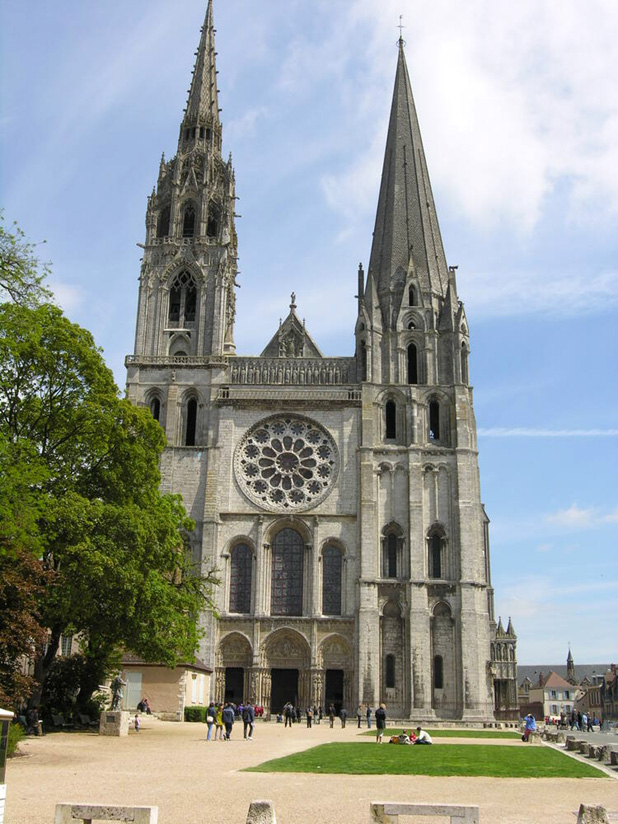Monet’s Challet – June 1991 Last Updated: April 2, 2022
This was one of our several earlier visits to Paris. On our first day in Paris, we decided to take a tour outside Paris. I had heard that the Chatre cathedral is very beautiful. So we decided to visit there.

I don’t know much about church or cathedral architecture but have visited most of the European famous churches. What I admire are the stained glass windows and the spires. Chartres Cathedral appears as an essential landmark in the history of medieval architecture. The outstanding stained-glass ensemble, monumental statuary of the 12th and 13th centuries, and the painted decorations miraculously preserved from the ravages of humankind and time make Chartres one of the most admirable and the best-preserved examples of Gothic art.
This Cathedral was very impressive – located in the Centre-Val-de-Loire region, it is one of the most authentic and complete works of religious architecture of the early 13th century.
Chartres Cathedral appears as an essential landmark in the history of medieval architecture. The outstanding stained-glass ensemble, monumental statuary of the 12th and 13th centuries and the painted decorations miraculously preserved from the ravages of humankind and time, make Chartres one of the most admirable and the best-preserved examples of Gothic art.
VISIT TO GIVERNY
The next day Sunday we decided to go to see Monet’s villa.

I had read an article about Monet’s beautiful chalet located in Giverny in New York Times travel section. Thus a visit to Giverny to see Monet’s chalet and the beauty of its garden which is very famous for water Lilies growing in a pond was the most important destination in our program. We were wondering how to manage train tickets late in the evening, but our hotel manager with his tiny office under the staircase told us he can book instantly on his computer and give us our train details and sit numbers.
So, well prepared the next morning we took the train, a number of youngsters were traveling with their bicycles.
When we got off at Giverny station we realized that there were no buses running on Sundays. We saw many people hiring taxis and that is what we did. I think we must have hopped onto the last taxi available at that time.
Many tourists were there. First, we walked around the house looking at family photos and some small paintings. There was a cafeteria where we had light lunch.
When we entered the garden, I felt like entering a Paradise if there is one .
These pictures bring vividly to my mind what I saw there. It is said that Monet was influenced by Japanese paintings. The top photograph of the bridge reflects that. He was also fascinated by water lilies.
There was a rivulet passing through his garden. And he created a pond drawing water from the rivulet. The pond is filled with water lilies. Monet has painted innumerable paintings of water lilies
Our friend on the bus tour to Chatres had recommended that to see Monet’s largest paintings we should go to a less well-known museum named Musee Marmottan where the paintings are placed in the lower floor of museum.
A circular wall is covered with huge paintings.
The Musée Marmottan Monet opened its spaces to Impressionism in 1940, when it became home to Monet’s iconic Impression, Sunrise.
In 1966 came another major event in the life of the collections: the museum became the universal legatee of Claude Monet via his son Michel. It thus inherited both the house in Giverny and the works that had remained in the family: over a hundred canvases retracing the career of the leading figure of Impressionism. In addition to masterpieces from the artist’s youth and maturity (The Train in the Snow. The Locomotive; Taking a Walk in Argenteuil; The Pont de l’Europe, Gare Saint-Lazare; The Houses of Parliament London, Reflections on the Thames, etc.) the ensemble is notable for the monumental canvases representing the water lilies and garden at Giverny. Never shown during the artist’s lifetime, these works were exhibited for the first time when they entered the Museum. The only institution to hold the last paintings of The Japanese Bridge and The House Seen from the Rose Garden, the Musée Marmottan Monet, home of the world’s leading collection of works by Monet, offers a unique experience of his art in terms of both quantity and rarity.
Our return journey was also as enjoyable because we walked in the grass along the road to the station. When tired we just sat down in the grass.
